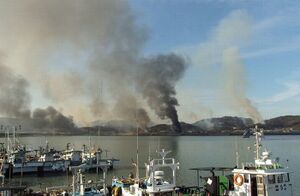2023 Tarijar Strait drone attacks
| 2023 Tarijar Strait drone attacks | |||||
|---|---|---|---|---|---|
| Part of 2023 Zalluabed conflict | |||||
 The port of Abu Kaniyah, Emmiria, during the attacks | |||||
| |||||
| Belligerents | |||||
|
|
| ||||
| Commanders and leaders | |||||
|
|
| ||||
| Casualties and losses | |||||
| |||||
Beginning on November 26th, 2023, forces loyal to Zalluabedi general Suhaib el-Dar Moussa near Kubani, Qahaza province, launched more than 80 explosive-laden UAVs and deliberately flew them into oil and port facilities in Albarine, Emmiria, and 4 ships transiting the Tarijar Strait. A total of 64 people were killed; 3 in the Albarinean port of Hervey, 7 aboard the oil tanker ML El-Izzaddeen, and 54 in the Emmirian ports of Tarijibar, Shafasab, Abu Kaniyah, and Mahaydah. Attacks continued sporadically for days, including a November 30th attack in Saint Raneau which left 72 dead.
Zalluabed's military-led government under interim-President Jirhanu Bjyala, embroiled in an ongoing civil war, stated that el-Dar Moussa had acted on his own and condemned the attacks as traitorous, but warned against military retaliation by WEDA. El-Dar Moussa was subsequently stripped of his rank and command, but he and his forces continued their campaign to seize control of Qahaza, now operating against both the military and the FZA rebels as the People's Republic of Qahaza.
In response to the attacks, WEDA increased their military presence in the Emmiria Sea and the Tarijar Strait. The Alliance of Nortuan States deployed ten naval vessels to join WEDA forces in the region, as Elbresian nationals had been killed on the El-Izzaddeen, and the embassies of Saint Offeat, Besmenia, and Greater Normark were hit during the Saint Raneau attack. This marked the first time since the World War that a multinational Nortuan naval force had been deployed for wartime purposes. On November 30th, the WEDA-ANS forces began Operation Afton which authorized member states to establish and enforce a no-fly zone over the PRQ, and to use "all necessary measures" to prevent attacks on civilians which turned into a bombing campaign by the forces of WEDA and ANS against Kubani Unit military installations and vehicles.
Background
Attacks
November 26
November 28
On November 28th, 33 drones were launched from Qahaza into the region around the Strait. 14 of them reached Albarine. All but two were shot down, with the surviving UAVs striking an oil pipeline and a power substation in the town of Denham, causing damage but no casualties. The remaining 17 UAVs were shot down over the Emmiria Sea by Emmirian Air Force Kowsir-2 fighters.
November 30
More than 80 drones entered Albarinean airspace. At least 30 were shot down, but the unprecedented scale of the drone fleet overwhelmed Albarine's air defense systems. The remaining drones reached Saint Raneau and slammed into structures around the city with purposeful targeting. Most of the drones hit industrial facilities and apartment complexes, which attributed to most of the casualties. A junior school in central Saint Raneau was hit by two drones, killing 4 sanitation crew and 2 teachers. A floral shop next to the Albarine Federal Bank was struck, killing two vendors. One drone exploded near the Harbour Bridge, but no fatalities were reported. A UAV struck the grounds of the Presidential Hall, destroying foliage and Christmas decorations and injuring a groundskeeper, but no one was killed and the President Phil Allais was not present at the time. The embassies of Saint Offeat, Besmenia, and Greater Normark were also hit, resulting in 4 deaths across the three structures. A total of 72 people died and more than 200 people were injured.